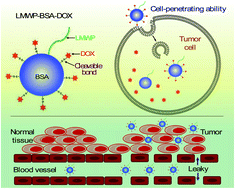Cell-penetrating albumin conjugates for enhanced doxorubicin delivery†
Abstract
Albumin-based

* Corresponding authors
a
Shanghai Institute of Materia Medica, Chinese Academy of Sciences, 501 Hai-ke Rd, Shanghai 201203, China
E-mail:
yzhuang@simm.ac.cn
Fax: +86 21 2023-1981
Tel: +86 21 2023-1000ext. 1401
b Zhengzhou University School of Pharmaceutical Sciences, 100 Science Rd, Zhengzhou 450001, China
c Guangzhou University of TCM, Tropical Medicine Institute, 12 Jichang Rd, Guangzhou 510405, China
d Key Laboratory of Smart Drug Delivery, Ministry of Education & PLA (Fudan University), Shanghai 201203, China
Albumin-based

 Please wait while we load your content...
Something went wrong. Try again?
Please wait while we load your content...
Something went wrong. Try again?
Q. Guo, H. Wang, Y. Zhao, H. Wang, F. Zeng, H. Hua, Q. Xu and Y. Huang, Polym. Chem., 2013, 4, 4584 DOI: 10.1039/C3PY00742A
To request permission to reproduce material from this article, please go to the Copyright Clearance Center request page.
If you are an author contributing to an RSC publication, you do not need to request permission provided correct acknowledgement is given.
If you are the author of this article, you do not need to request permission to reproduce figures and diagrams provided correct acknowledgement is given. If you want to reproduce the whole article in a third-party publication (excluding your thesis/dissertation for which permission is not required) please go to the Copyright Clearance Center request page.
Read more about how to correctly acknowledge RSC content.
 Fetching data from CrossRef.
Fetching data from CrossRef.
This may take some time to load.
Loading related content
